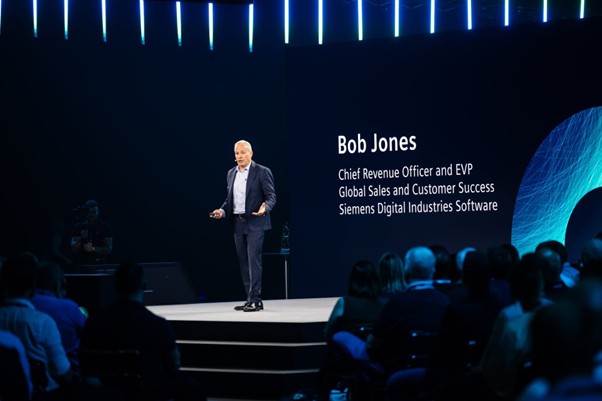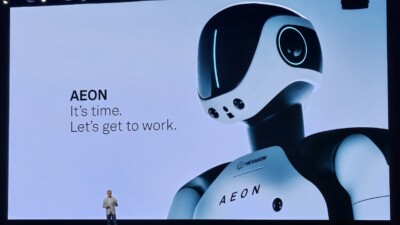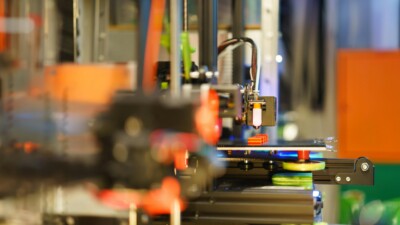Complexity is not a problem to solve, it’s an advantage to harness.
At Siemens Realize LIVE Europe 2025, the message was clear: complexity is not a problem to solve—it’s an advantage to harness. AI, digital threads, and domain-specific PLM are no longer future concepts; they are converging into operational realities.
This year’s event illustrated how Siemens is doubling down on the strategy it has long articulated: enabling faster innovation by embedding intelligence, integration, and collaboration into the digital backbone of manufacturing and product development.

Record attendance at Siemens Realize LIVE 2025 in Amsterdam, with Jones discussing the key to mastering complexity; and of course, that includes the use of AI. (Image: Siemens.)
AI as a strategic accelerator
AI at Siemens has moved beyond pilots—now, the race is on for scale. As Bob Jones, Chief Revenue Officer and EVP of Global Sales and Customer Success, put it: “It’s not just about adopting AI—it’s about being the fastest to adopt it.” Speed matters.
Jones emphasized mastering complexity through AI. Siemens is embedding intelligence across the Xcelerator portfolio to boost speed, clarity, and confidence in decision-making:
- Ask, find, act: Teamcenter Copilot and AI Chat allow users to query data in natural language, surfacing insights instantly.
- Fix faster: RapidMiner spots quality issues and recommends improvements.
- Make documents dynamic: AI extracts procedures from static PDFs to accelerate training and compliance.
- Automate handoffs: Teamcenter, Rulestream, and Mendix streamline design-to-order workflows.
Joe Bohman, EVP of PLM Products, summed it up: Siemens is “training AI in the language of engineering and manufacturing.” This is not about generic automation—it is about embedding domain-specific intelligence aligned with physics, lifecycle context, and operational constraints.
Reinforcing that intent, Siemens appointed Vasi Philomin—former AWS VP of Generative AI—as EVP of Data and AI, reporting to CTO Peter Koerte. At Amazon, Philomin launched Amazon Bedrock and led foundation model development. His arrival signals Siemens’ commitment to scaling industrial AI as a foundational capability—not a feature—across the Xcelerator suite.
From static data to dynamic digital threads
A deeper shift is underway: from managing Bills of Materials to orchestrating Bills of Information. Is this just new language or real change? Either way, it reflects a move from static data capture to dynamic, role-based information delivery across the product lifecycle-enabling faster, more informed decisions at every stage.
Siemens is championing a PLM architecture that supports this shift, built around:
- Secure, object-level data access tailored to specific roles and responsibilities.
- Microservices and large language models (LLMs) delivering contextual guidance across engineering, manufacturing, and service domains.
- A digital thread backbone connecting design, production, quality, and support in real time.
As advertised, this approach goes well beyond traditional traceability. It unlocks the ability to deliver the right data, in the right format, to the right person—when and where it is needed. It transforms engineering knowledge from static documentation into living, operational intelligence.
For globally distributed and regulated industries, this kind of digital continuity is no longer optional—it is a minimum requirement. Engineering is being redefined not just by tools, but by how data is structured, shared, and transformed into actionable insights that drive innovation and execution at scale.
Rethinking CPG
Siemens is reimagining PLM for the CPG industry, extending Teamcenter beyond packaging to support end-to-end collaboration across R&D, regulatory, marketing, and supply chain. By integrating formulation and specification management—built on Opcenter RD&L—Siemens is positioning Teamcenter to compete with SAP PLM in process-heavy, compliance-driven sectors. The solution is promising but still maturing.
A recent partnership with FoodChain ID boosts this trajectory by embedding global regulatory intelligence into the digital thread, helping CPG companies design for compliance from the start.
Key focus areas include:
- Formulation and specification support, bridging science-led R&D with enterprise PLM.
- Cross-functional collaboration across R&D, regulatory, marketing, and sourcing in a shared digital workspace.
- Recipe reuse across global sites, increasing agility and compliance—as demonstrated by Unilever.
- Scenario modeling and digital twins, enabling design-for-supply-chain strategies.
- Regulatory intelligence integration, to guide compliant product development from the outset.
While Siemens’ CPG capabilities are evolving, the strategy requires further clarity. The long-term goal is ambitious: to build a robust PLM backbone that accelerates product innovation while addressing regulatory compliance and supply chain complexity from day one.
Xcelerator-as-a-service and agent-driven automation
Building on this momentum, Siemens’ Xcelerator-as-a-Service approach follows a clear goal: keep things simple, flexible, and always up to date.
Key enablers include:
- Lifecycle data management, with built-in traceability and change control.
- Low-code tools, via Mendix, embedded across Teamcenter and Opcenter.
- AI agents, reducing manual effort, streamlining workflows, and reinforcing governance.
The transition toward software-defined products is accelerating. Siemens is doubling down on:
- SysML v2, enabling next-generation model-based systems engineering
- Polarion, aligning software and hardware requirements in unified backlogs
- Supplier frameworks, integrating BOMs and compliance for cross-domain coordination
This is more than a technical evolution—it is a strategic upgrade toward future-ready operations, where complexity is coordinated, traceable, and compatible by design.
Regulatory-ready digital twins and Industry 4.0 interoperability
Regulation is not lagging behind innovation anymore—it is driving it. The upcoming EU Digital Product Passport (DPP 4.0) marks a turning point. Siemens is preparing its customers to meet these mandates not as a constraint—but as a catalyst for trustworthy digital systems.
Their approach includes:
- Asset Administration Shell (AAS): machine-readable digital twins that maintain continuity from design through operation.
- OPC UA-based interoperability: enabling secure, standards-based data exchange across partners and platforms.
- Embedded sustainability and compliance tracking: making ESG and traceability data a native part of the engineering model.
This is digital transformation built for permanence. With regulations requiring traceable, reusable digital records, AI can only accelerate what is built on the right data foundation.
Make no mistake. Complexity is not just managed; it is mined for advantage. The metaphor echoed at the event is apt: like bamboo, digital transformation takes time to root—but when it does, it grows fast and strong. For industrial leaders, the question is no longer why transform—but rather: How fast can intelligence be embedded into the product and value chain?




